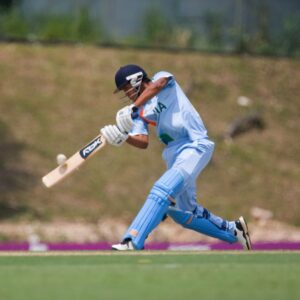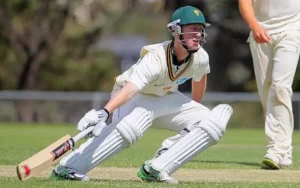There is far more importance to strength training for improved sports performance than simply adding some muscle to your body. Strength training aims to improve the baseline from which all physical attributes are expressed – in other words, actions such as a more powerful cover drive or a more powerful throw when fielding, are the aims of performing strength based work for cricket. However, the situation isn’t as simple as just going and doing some weight training, and automatically your batting or your throwing is better. The work must be targeted and specific to the cricket movements. Unfortunately, much of the strength based work that is often aimed at improving a cricketers physical capacities (although this is by no means unique to cricket – athletes from all sports are guilty of this) takes on a very un-specific bodybuilding type of look. This includes things like;
- Splitting the body into parts (‘chest day’, ‘shoulders day’, ‘biceps day’ and even once every few months the occasional ‘leg day’)
- Lots of pin or plate-loaded machine training
- 3 sets of 10 for every exercise, all year long
- Being very mirror focused
- Isolation exercises using single muscles on their own (bicep curls, triceps extensions, shoulder raises, shrugs, etc.)
- Training muscles rather than movement
It is important to say straight up that this is simply wrong in terms of conditioning for cricket. This isn’t functional training for cricket, or anything in life for that matter, apart from bodybuilding competitions. In the next section we cover what exactly ‘functional’ means, with particular focus on what we are aiming to achieve, which is a greater physical capacity to be better cricketers.
It is important to not lose sight of the fact that strength training is only one aspect of training for cricket. There are of course many other aspects or physical qualities that go into performance improvement, particularly things like running ability, speed, agility, explosive power, acceleration and deceleration, coordination as well as the often less thought of factors like injury reduction and movement efficiency (and of course the actual skills and tactics). But the reality is that strength is the underlying quality of most, if not all the other variables in physical performance, and as a result, you cannot improve in any these qualities, if you haven’t improved on your baseline of strength first. That is, you will not be able to accelerate, decelerate and change directions more effectively and with less likelihood of injury, if you haven’t first developed your functional strength capacity to do this. Internationally renowned strength and conditioning for sports expert Vern Gambetta says it himself in his book Athletic Development: The Art & Science of Functional Sports Conditioning;
“In the athletic development process, strength training is possibly the most important area because it is the underlying quality of so many other components.”
So it is important to understand that we are not just strength training in order to build muscle. Indeed if you are simply just building muscle, without improving in maximal strength, speed, acceleration, deceleration and other important aspects of cricket, the stark reality is you are actually going backwards, by adding more weight to your frame, and therefore meaning your cardiovascular and respiratory systems now have to work even harder to carry that frame around than previously, without actually adding any physical performance improvement. You may look more impressive in the mirror, but that is not the name of the game in our sport.
So understand that we are strength training for improvements in functional performance, not just in functional strength that can actually be used in cricket, but also in order to improve in all the other aspects of physical performance (agility, throwing, acceleration and deceleration, etc) that first require an improvement in strength to build on.
Also remember that strength training is only one piece of the puzzle for physical performance in cricket (along with running, skills, etc), albeit a very important and underrated one. So don’t fall into the trap that many players often can of losing sight of the end goal, and seeing strength training and muscle development as an ‘end’ in itself.
So these developments in athletic ability for cricket actions include;
–Acceleration (think pace bowling, running between wickets)
-Deceleration and direction change (think running between wickets)
–Landing (think the last step or 2 when delivering a fast bowl)
-Shoulder stability and health (injury reduction)
-Core and lower back strength (greater power generating ability and injury reduction)
-Powerful torso rotation (batting as well as bowling)
–Powerful throw (single leg strength, torso rotation, shoulder stability)



If any of these things are goals of yours to improve, then a developing foundation of functional and specific strength ability will only contribute towards this goal. However it is important to highlight that merely doing any kind of strength work will not necessarily transfer to these goals. Simply following standard body building practices or programs for muscle development will not automatically contribute to these goals, and in actual fact can take away from them.
The training must be targeted at the sport of cricket and its specific needs, which is exactly what this site aims at doing.
So read on, and ensure that not only are you actually strength training, but that you are being targeted and specific towards cricket with this strength training.

Cricket Athlete